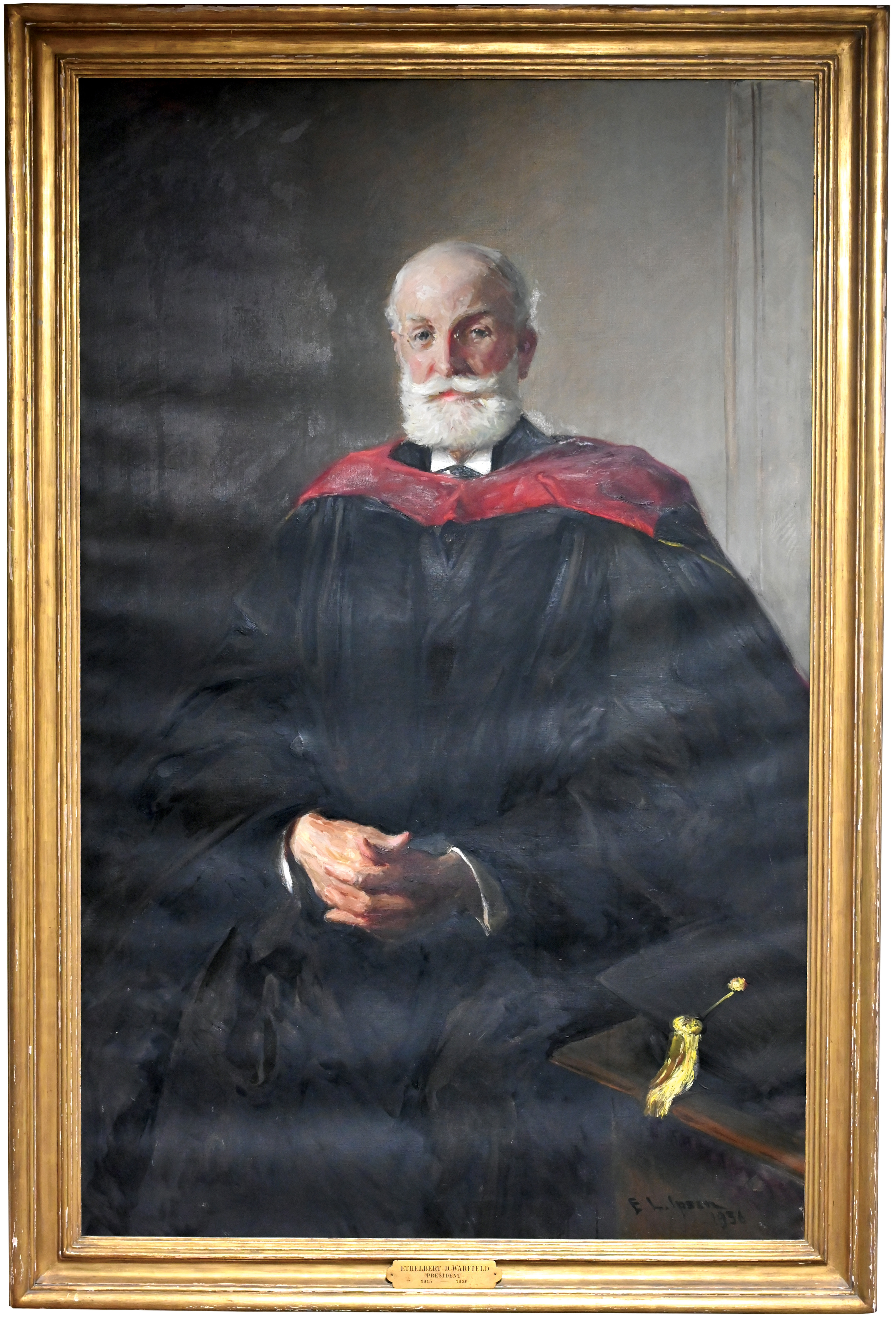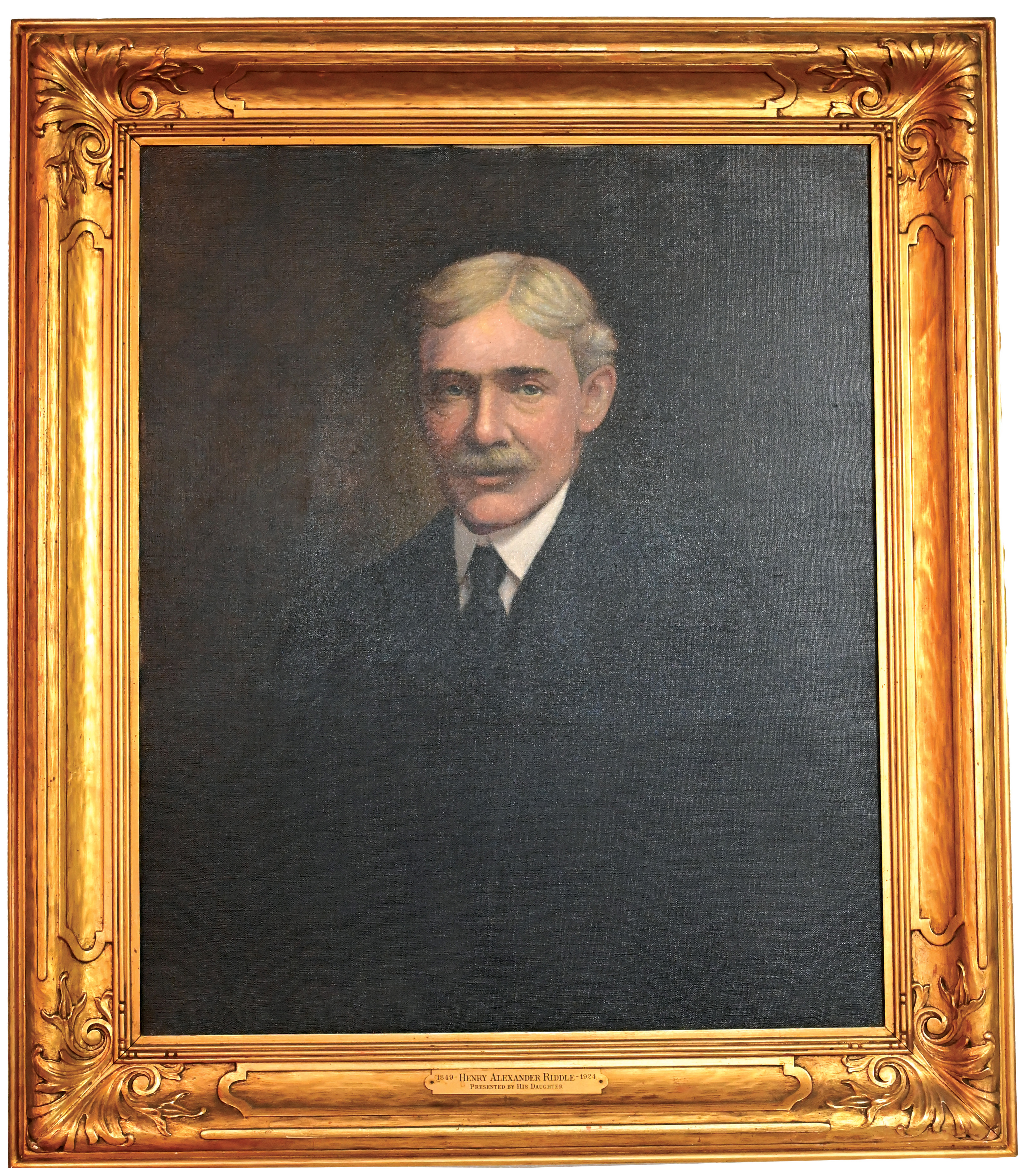By Sandra Huffman ’86, Philip Lindsey, and Maxine Wagenhoffer
One of the most popular events held during ArtsFest 2024 was a presentation by Philip Lindsey, M.F.A., professor of fine arts, titled “A Look at President Jensen’s Portrait: The Sitter, The Artist, and the Process.” His talk sparked an animated discussion among those in attendance about what other portraits are located around the College campus. The following article focuses on a few interesting portraits commissioned by or gifted to the College throughout the years and includes historic research conducted by Maxine Wagenhoffer, Ph.D., director of the Hankey Center for the History of Women’s Education, and artistic evaluations by Professor Lindsey.
Academic institutions often encapsulate the portrayal of leadership in the art of portraiture. Portraits serve not only as a visual representation of the individuals who shape an institution, but also as a symbol of respect and recognition for the leadership their subjects provide. “Every leader connected to an institution does not receive a portrait, and one’s understanding of leadership can vary from person to person and from generation to generation. Who gets a portrait, who paints a portrait, and how a portrait is unveiled reveals volumes about our society’s evolving definitions of leadership,” said Wagenhoffer.
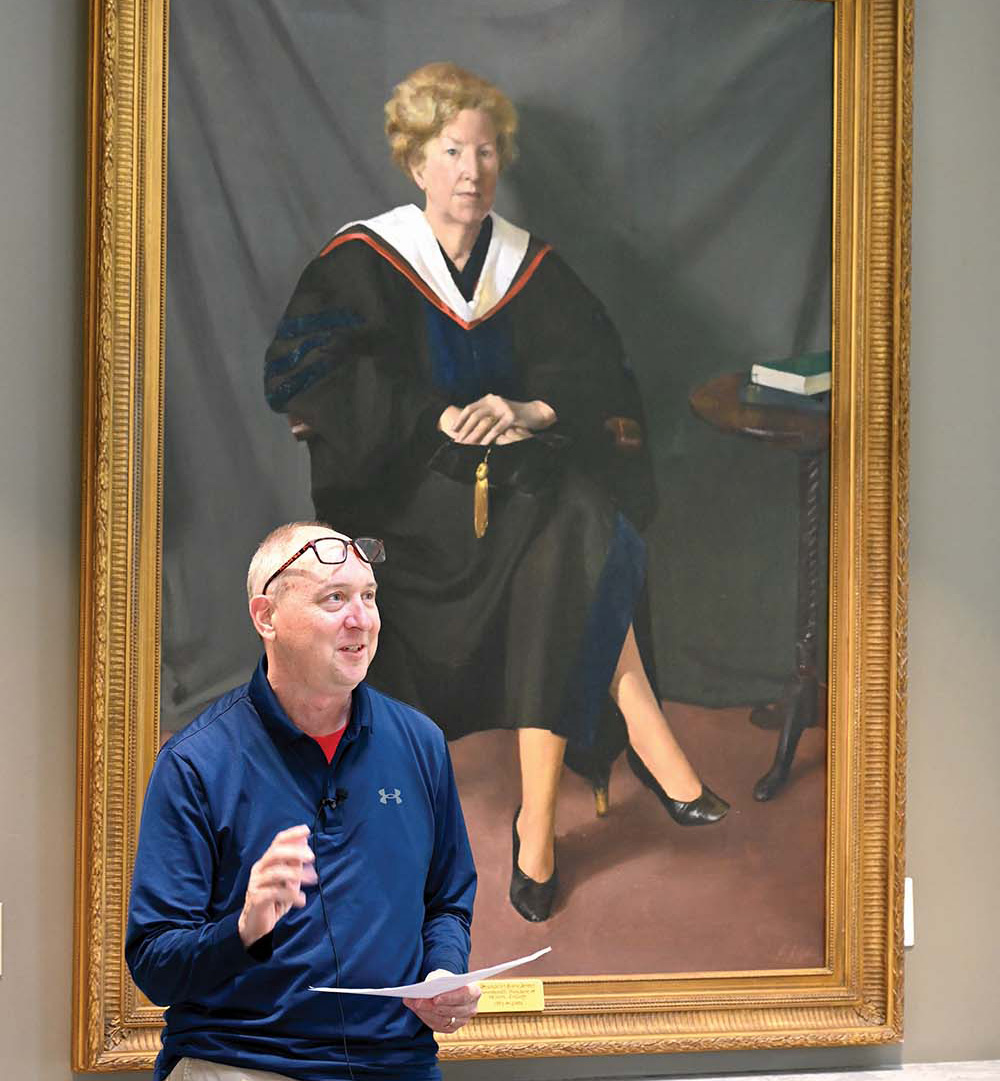 Gwendolyn Evans Jensen, Ph.D.
Gwendolyn Evans Jensen, Ph.D.
Artist Rita Natarova (1980-present) was born in Moscow and immigrated to the United
States in 1992. She received her Bachelor of Fine Arts in Painting from the Maryland
Institute College of Art and studied painting at the Jerusalem Studio School and Brooklyn
College. She holds her Master of Fine Arts in Painting from the University of Pennsylvania.
(“2007 Visiting Faculty: Rita Natarova.” Studio Escalier, 2013)
Pictured: Philip Lindsay, M.F.A., professor of fine arts, discusses the portrait of former
Wilson President Gwendolyn Jensen during ArtsFest 2024.
The way artists paint portraits and the way people celebrate them often convey the person’s leadership style and the cultural contexts of their respective times. “Painting a portrait requires the artist to walk a bit of a tightrope. The artist, in pursuing truth, must balance flattery without being artificial,” said Lindsey.
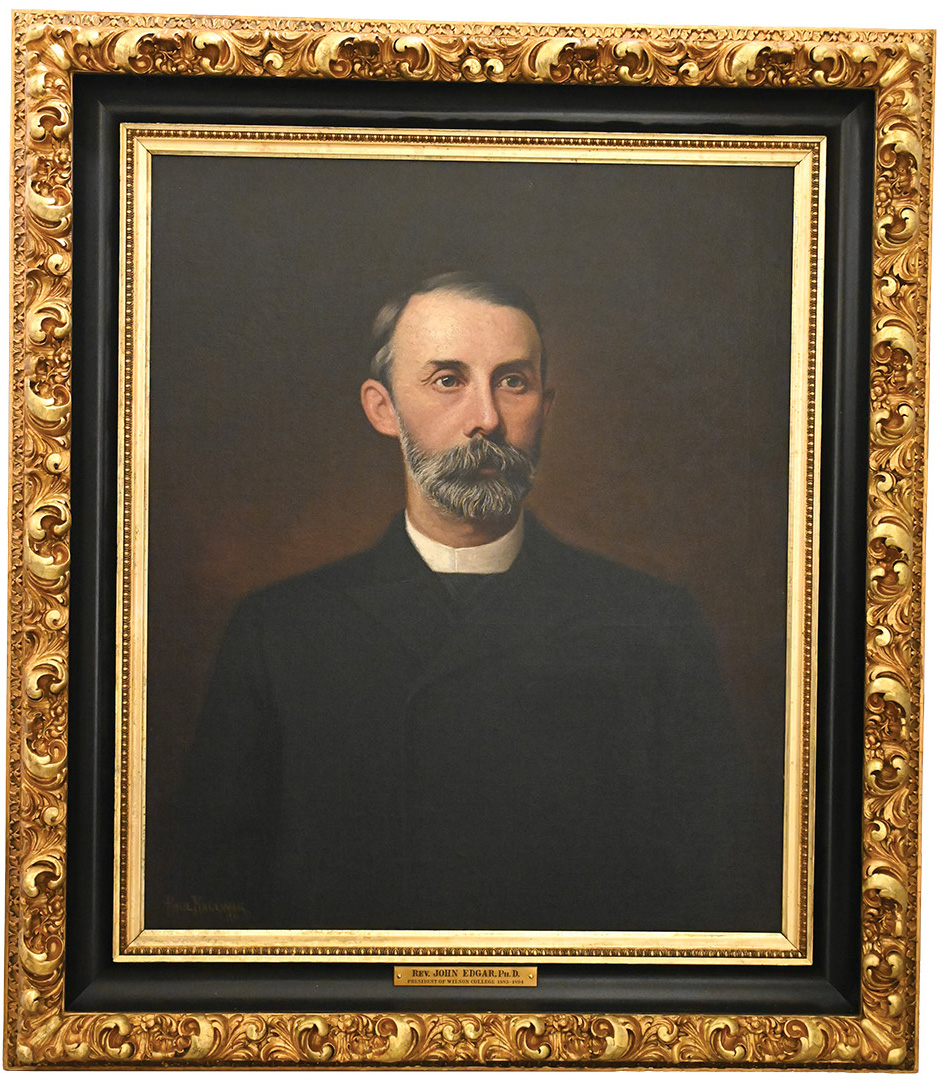 Rev. John Edgar
Rev. John Edgar
Artist Paul Hallwig (1865-1925) of Baltimore studied portraiture under his father, Oscar, and
received a degree from the Maryland Institute before studying at the Academy of Fine Arts
in Munich. Among his prominent subjects were Baltimore Mayor Robert C. Davidson and
Luitpold, Prince Regent of Bavaria, establishing his reputation in the art world. (“Baltimore
Artist Dies Following Brief Illness,” The Baltimore Sun, Oct. 2, 1925)
For example, a portrait of an early college president, the Rev. John Edgar (1883-1894), looked out on visitors to Edgar Hall for many years, but now sits in the Hankey Center awaiting relocation after being refurbished. This portrait, painted by famed portrait artist Paul Hallwig, was unveiled in June 1910 during Wilson Alumnae Day at the same time as the portrait of Rev. Tryon Edwards, one of the College’s founders and first presidents. The June 8, 1910 issue of Chambersburg’s Franklin Repository newspaper described the event: “Amid a deep silence which hushed the crowded library Miss Charlotte Davison, of Chambersburg, member of the college faculty, drew aside the hangings, revealing the pictured faces of two men whom Wilson delights to honor.”
In his portrait, Edgar does not look at the viewer, but is in a frontal, half-length pose with harsh lighting from the upper left. He wears a dark suit against a warm, dark background. The simple black topcoat with the clerical collar speaks to the restraint of a man of the cloth, reinforced by the artist’s matter-of- fact handling of form, said Lindsey. Space beyond Edgar opens slightly just to his left. He occupies space quite close to the picture plane, a device employed by portrait painters since the Renaissance to compress space and give the impression that the sitter is close to us. Lindsey described Edgar’s image as “rather austere, stiff, rigid, and more illustrative than poetic, with an emphasis on facial detail, rather than painterly finesse.”
Rev. Ethelbert Dudley Warfield, D.D., LL.D.
Artist Ernest Ludvig Ipsen (1869-1951) trained at the School of the Museum of Fine
Arts, Boston, and the Royal Danish Academy of Fine Arts in Copenhagen. He was
a member of the National Academy of Design. His notable portraits include U.S.
President William Howard Taft and General Robert E. Lee. (“Ernest Ludwig Ipsen,”
National Academy of Design website, 2021)
In contrast to the serious portrait of Rev. Edgar is the portrait of former College President Ethelbert D. Warfield, D.D., LL.D. (1915-1936). Ernest Ludvig Ipsen’s portrait of Warfield was unveiled during Alumnae Day in 1936. The presentation of the portrait, together with the naming of Warfield Hall, were among the honors bestowed upon his retirement.
“Painting a portrait requires the artist to walk a bit of a tightrope.”
The portrait of Warfield is sincere, bold, brushy, and loosely handled. Ipsen leads the viewer to specific conclusions about what they see by controlling the chromatic structure of warm highlights and cool shadows. Close examination of the hands, whiskers, and robe reveals little more than suggestions of form. Two red and pink slashes create the mere illusion of a mouth.
“At the time, the style was considered without dash or bravura, a serious representation for a serious sitter. By today’s standards, the painting looks almost wind-swept with splash and dash!” said Lindsey.
During Warfield’s presidency, the College added several new buildings, including The Henry Alexander Riddle Memorial Hall, dedicated during commencement weekend in June 1928 and named to honor the long-term trustee. Dr. Anna J. McKeag, former college president of Wilson (1911-1915), highlighted Riddle’s impact on the institution during the dedication ceremony.
For many years, the portrait of Henry Riddle has occupied a prominent position in Riddle Hall above the fireplace mantle in the lounge. An article in the August 1928 issue of the Wilson Alumnae Quarterly described the portrait as a striking likeness that captured Riddle’s essence: “The portrait is the first thing to attract the attention of a person entering the room, and it lends a friendly and peaceful atmosphere to the building, such as only a man like Mr. Riddle could give.”
The portrait features a traditional bust-length representation, with Riddle depicted in a black sport coat and a white shirt, exuding warmth and kindness through his expression. The use of light and shadow in the painting enhances its emotional depth, inviting viewers to connect with Riddle’s character. Interestingly, he is smaller than life-size, although there is plenty of space within the painting to have made him larger. The smaller scale pushes the figure into the picture plane, further away from the viewer than what we often see with traditional portraits. The space around him is dark, with just a hint of light to his right.
According to Lindsey, these artistic choices contribute significantly to its impact. Riddle’s smaller-than-life-size representation, combined with the dark background, creates a sense of intimacy and draws the viewer’s focus to his face. The warm skin tone and gentle light from the upper right add to the overall inviting atmosphere of the piece. This portrayal not only reflects Riddle’s demeanor but also serves to engage the audience, making them feel a personal connection to the figure depicted. “His eyes are light with a sense of kindness and his skin tone is warmer than most of the portraits that hang around campus, perhaps speaking to Riddle’s demeanor,” said Lindsey.
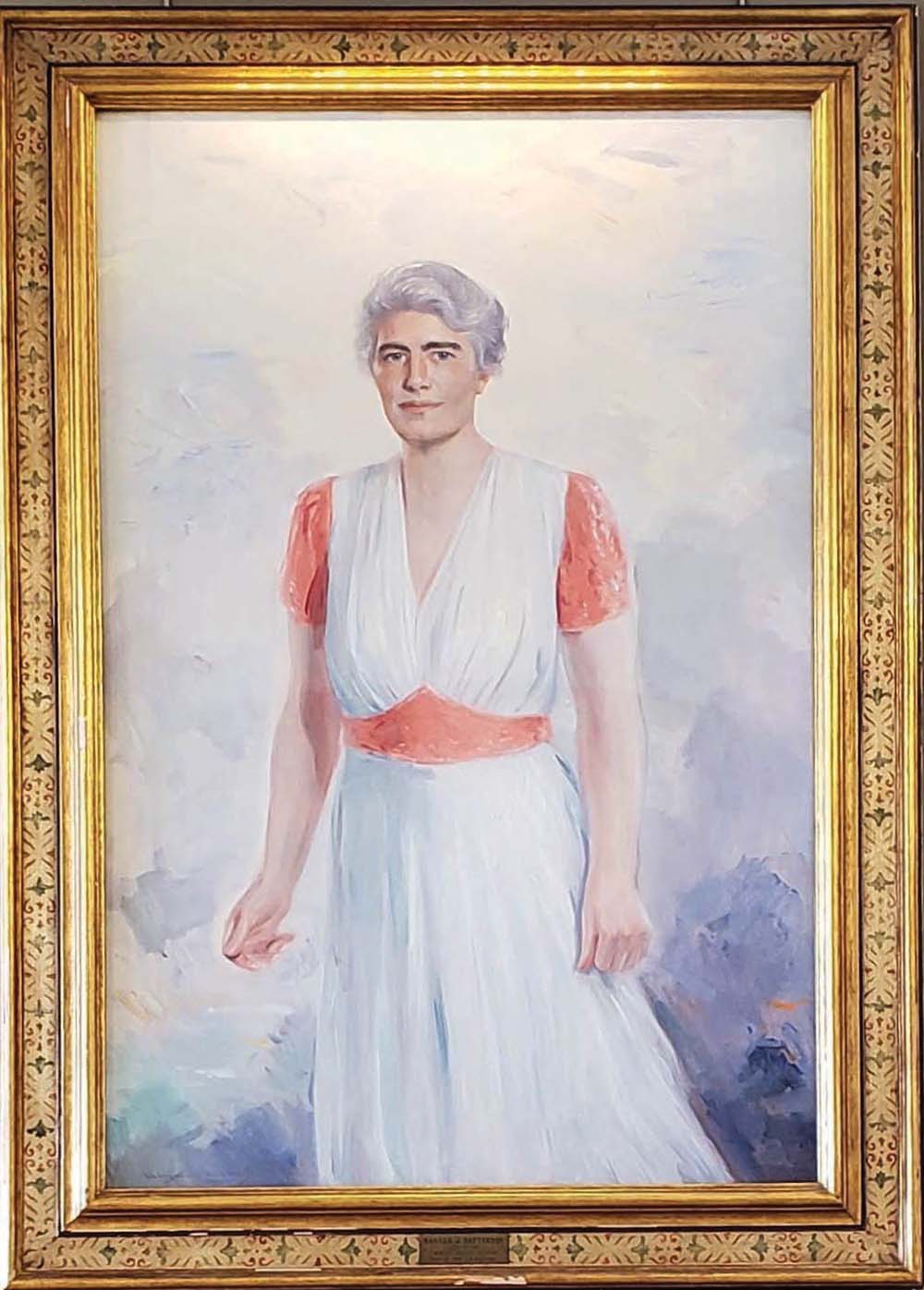 Hannah J. Patterson, Class of 1901
Hannah J. Patterson, Class of 1901
Artist Wayman Elbridge Adams (1883-1959) began portrait painting while studying
at the Herron School of Art in Indianapolis. He continued his studies in Italy and
in Spain, and at the Grand Central Art School in NYC. He would complete an entire
portrait in one sitting which earned him the nickname “Lightning.” (The Alan Mason
Chesney Medical Archives. “Wayman Adams.” The Johns Hopkins University, 2024)
Equally familiar to most on campus is the portrait of suffragist Hannah J. Patterson, class of 1901, which hangs in Laird Hall’s Patterson Lounge. Patterson also served as a trustee of the College (1913-1917 and 1922-1937). Her posthumous portrait was painted by Wayman Elbridge Adams (1883-1959) in 1938, on commission for Mrs. J.B. Roessing, a good friend of the subject.
Because Patterson gave much of herself to Wilson and the community as a student and trustee, Roessing donated the portrait to the College. Judge Sara M. Soffel delivered an address at the 1938 unveiling and said, “In presenting this portrait to Wilson College, I know that Mrs. Roessing has been actuated by the hope that the undergraduates assembled here today, and their sisters of tomorrow, may find in the life of Hannah Patterson the stimulus and the inspiration that will drive them on to higher deeps, to nobler achievements. For hers are deeds which should not pass away. Hers a name that must not wither.
The portrait is a three-quarter-view of Patterson in an airy white dress, with red short sleeves and sash. She faces the viewer with arms at her sides, her steely jaw held tight as her eyes meet those who gaze upon her. Wavy grey hair that feels as light as her dress frames a wide mouth and dark eyebrows. “As posthumous portraits go,” Lindsey said, “this one offers a sense of her intelligence, compassion, strength, and fortitude. However, there is little detail or attention given to her arms and hands. They hang loosely, though disproportionately large. They read with an odd, powerful tubular-ness, while also giving a sense of warm assurance.”
Finally, the portrait of former College President Gwendolyn Jensen, Ph.D. (1991-2001) which initiated this analysis, hangs on the wall just opposite of Patterson’s in the Patterson Board Room. Jensen was devoted to women’s education and empowerment, which became the context for the portrait painted in 2001 by Rita Natarova (1980- ), an undergraduate Russian art student from the Maryland Institute College of Art (MICA). In the spring of 2001, Jensen posed for over 40 sessions with the artist, using music and locations in Norland and Thomson Halls to power through the over 100 hours of sittings.
One of the most fascinating aspects of this painting is that Natarova used a palette knife instead of traditional brushes to complete it, a process she had mastered at the age of twenty-one. Using this technique, Natarova created the fine surface qualities of flesh, hose, wood, and fabric.
In the portrait, Jensen sits in a black lacquer, wooden Wilson College chair, with a simple green drape behind her, and a small table with books to her side. She sits cross-legged in traditional academic regalia. Her cap and tassel are in her lap. The chewed legs of the chair are a nod to Jensen’s beloved Golden Retrievers. With each subtle detail, Lindsey remarked, Natarova captured the wisdom, integrity, intelligence, vision, and grace of her subject.
“Even with different artists and with these historical actors possessing a variety of roles at the College across the decades, these five portraits highlight the long tradition of strong leadership at Wilson,” said Wagenhoffer.

